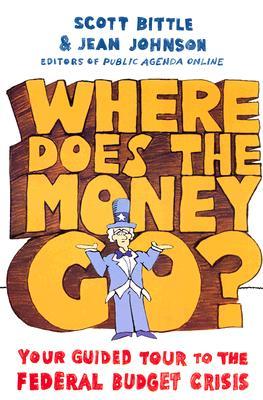Where Does the Money Go? Your Guided Tour to the Federal Budget Crisis, by Scott Bittle and Jean Johnson
Mar 6
2008

Wordcandy doesn’t review much nonfiction, but we were pleasantly surprised by Jean Johnson and Scott Bittle’s Where Does the Money Go? Your Guided Tour to the Federal Budget Crisis. Miraculously, Johnson and Bittle have managed to write a politically unbiased book on an important-but-drier-than-dust subject that is both informative and entertaining.
Despite the fact that the United States’ massive national debt—nine trillion and counting!—will affect most of our lives, few American citizens understand the finer points of our nation’s finances. With Where Does the Money Go?, Johnson and Bittle set out to change that. Using clear, accessible language and an entertainingly irreverent style, they analyze everything from the trade deficit to pork-barrel spending. Check out their explanation of the Social Security trust fund (Social Security makes up over twenty percent of our current budget, and the authors clearly consider it to be the thorniest problem looming on the nation's financial horizon):
Where Does the Money Go? attacks both liberal and conservative sacred cows: the authors point out that the national debt won’t be resolved by cutting out programs like welfare (2.67% of the budget), or the National Endowment for the Arts (0.009%); nor will it be resolved by withdrawing from Iraq and Afghanistan (national defense = 19.7%). Unfortunately, Bittle and Johnson insist, the only way to reduce our vast national debt is to both raise taxes and cut services on a scale that’s going to make pretty much everyone unhappy.
Even if you're already familiar with some or all of the stops on Johnson and Bittle’s “guided tour”, it’s always useful to be reminded of the issues at stake. (A nine trillion dollar debt works out to about $30,000 dollars’ worth of debt per American citizen. Imagine adding that to your tax bill next month.) No matter what your political values are, Bittle and Johnson make a convincing argument that you should add the national economy to your list of things to worry about.
Despite the fact that the United States’ massive national debt—nine trillion and counting!—will affect most of our lives, few American citizens understand the finer points of our nation’s finances. With Where Does the Money Go?, Johnson and Bittle set out to change that. Using clear, accessible language and an entertainingly irreverent style, they analyze everything from the trade deficit to pork-barrel spending. Check out their explanation of the Social Security trust fund (Social Security makes up over twenty percent of our current budget, and the authors clearly consider it to be the thorniest problem looming on the nation's financial horizon):
"5. True or false? Money in the Social Security trust fund is only spent on Social Security.See? Totally depressing, but crystal clear!
Answer: Nope. Money raised through Social Security taxes that is not immediately needed to pay Social Security benefits to elderly Americans can be lent (and has been lent) to the federal government to cover other programs and tax cuts. Sometimes people are distressed, even infuriated, when they learn about this, but the “borrowing” isn’t illegal or even secret. In recent years, the huge baby-boom generation has been working and paying Social Security taxes, so there has been quite a lot of “extra money” in the trust fund. The rest of the government has depended on the Social Security piggy bank to avoid having to raise taxes or cut other kinds of government spending. Social Security does have IOUs for money that’s been spend elsewhere (actually, Treasury bonds), but it will need to start redeeming them when the boomers start retiring. Since the U.S. government routinely operates in the red and is now roughly $9 trillion dollars in debt, coming up with the money to cover those IOUs is not going to be easy."
Where Does the Money Go? attacks both liberal and conservative sacred cows: the authors point out that the national debt won’t be resolved by cutting out programs like welfare (2.67% of the budget), or the National Endowment for the Arts (0.009%); nor will it be resolved by withdrawing from Iraq and Afghanistan (national defense = 19.7%). Unfortunately, Bittle and Johnson insist, the only way to reduce our vast national debt is to both raise taxes and cut services on a scale that’s going to make pretty much everyone unhappy.
Even if you're already familiar with some or all of the stops on Johnson and Bittle’s “guided tour”, it’s always useful to be reminded of the issues at stake. (A nine trillion dollar debt works out to about $30,000 dollars’ worth of debt per American citizen. Imagine adding that to your tax bill next month.) No matter what your political values are, Bittle and Johnson make a convincing argument that you should add the national economy to your list of things to worry about.
Posted by: Julia, Last edit by: Julianka
No new comments are allowed on this post.
Comments
No comments yet. Be the first!